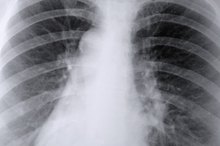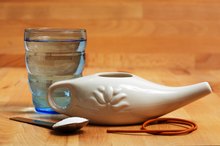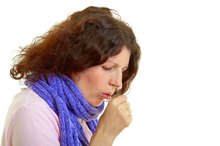Breathing & Phlegm
According to MedlinePlus.com, the average adult takes about 8 to 16 breaths each minute 1. Air enters your body through your nose and travels down your bronchial tubes and into your lungs. Phlegm works with your respiratory system, interacting with the air you breathe. Breathing is a natural process that your body should perform effortlessly and automatically. However, sometimes certain factors can interfere with your ability to breathe comfortably.
If you are experiencing serious medical symptoms, seek emergency treatment immediately.
Phlegm
Phlegm is a substance that is produced by the cells that line your throat, lungs and nasal passages. Phlegm’s primary purpose is to lubricate the soft lining in your respiratory system and to help keep the air that you breathe in from burning the sensitive skin in your nose. Without phlegm, breathing in air would be extremely uncomfortable. Phlegm also works to trap unwanted substances like dust and bacteria, and expel them from your respiratory system. While some phlegm production is normal, excessive phlegm production can be a problem.
- Phlegm is a substance that is produced by the cells that line your throat, lungs and nasal passages.
- Phlegm also works to trap unwanted substances like dust and bacteria, and expel them from your respiratory system.
Effects
Allergies & Chest Congestion Symptoms
Learn More
When your body makes more phlegm than it needs, the excessive phlegm can clog your nasal passages making it difficult to breathe. Nasal congestion caused by phlegm buildup can feel extremely uncomfortable and even painful. Excess phlegm can also accumulate in your lungs and throat. Phlegm is normally clear or white in color and thin in consistency. Discolored phlegm that appears yellow or green in color, or phlegm that is unusually thick may indicate the presence of a bacterial infection.
- When your body makes more phlegm than it needs, the excessive phlegm can clog your nasal passages making it difficult to breathe.
Causes
Several health problems can provoke your body to produce excess phlegm that interferes with your breathing. According to Cancer.gov, infections like a cold and the flu are among the most common triggers 3. If you have a cold or the flu, constantly coughing to clear away excess phlegm from your throat can make you feel short of breath. Bronchitis is another common trigger for excess phlegm production. Bronchitis occurs when the lining of your bronchial tubes becomes inflamed and scarred, triggering excessive phlegm and shortness of breath.
- Several health problems can provoke your body to produce excess phlegm that interferes with your breathing.
- If you have a cold or the flu, constantly coughing to clear away excess phlegm from your throat can make you feel short of breath.
Risk Factors
How to Stop Sinus Drainage in the Throat
Learn More
Cigarette smoke is one of the biggest risk factors for bronchitis. According to MayoClinic.com, smoking cigarettes and frequent exposure to secondhand smoke increases your risk of developing bronchitis 2. Long-term exposure to irritants such as cleaning products, paint and strong chemical fumes can also trigger bronchitis. Having a weak immune system may make you more susceptible to developing infections like a cold or the flu. If you suffer from asthma, you may have a more difficult time trying to breathe when phlegm blocks your airways.
- Cigarette smoke is one of the biggest risk factors for bronchitis.
- If you suffer from asthma, you may have a more difficult time trying to breathe when phlegm blocks your airways.
Treatments
One way to get relief from thick, excess phlegm that blocks your breathing is to make your phlegm thinner. You can do this by drinking plenty of fluids and by taking an over-the-counter antihistamine medication. Placing a humidifier in the room will inject the air with warmth and moisture which can help loosen up thick phlegm. Use a saline nasal spray to help break up the phlegm blocking your nasal passages and improve your breathing. A bacterial infection that produces discolored phlegm may require treatment with antibiotics.
- One way to get relief from thick, excess phlegm that blocks your breathing is to make your phlegm thinner.
Related Articles
References
- MedlinePlus.com: Nasal Discharge
- MayoClinic.com: Bronchitis
- Cancer.gov: Phlegm
- MedlinePlus.com: Rapid shallow breathing
- Lillehoj EP, Kato K, Lu W, Kim KC. Cellular and molecular biology of airway mucins. Int Rev Cell Mol Biol. 2013;303:139-202. doi:10.1016/B978-0-12-407697-6.00004-0
- Bills G, Rose C. Principles of Pharmacology for Respiratory Care. Sudbury, MA: Jones & Bartlett Learning; 2019.
- Fahy JV, Dickey BF. Airway mucus function and dysfunction. N Engl J Med. 2010;363(23):2233-47. doi:10.1056/NEJMra0910061
- Seaton A, Leitch G, Seaton D. Crofton and Douglas's Respiratory Diseases. Hoboken, NJ: Wiley; 2008.
- Scaglione F, Petrini O. Mucoactive agents in the therapy of upper respiratory airways infections: fair to describe them just as mucoactive?. Clin Med Insights Ear Nose Throat. 2019;12:1179550618821930. doi:10.1177/1179550618821930
- American Thoracic Society. (2015). What Are the Signs and Symptoms of COPD?
- Centers for Disease Control and Prevention. (n.d.). Runny Nose (with green or yellow mucus).
- Martínez-girón R, Mosquera-martínez J, Martínez-torre S. Black-Pigmented Sputum. J Cytol. 2013;30(4):274-5.
- Nadel, J.A. (2016). Airway Epithelium and Mucous Secretion. Murray and Nadel's Textbook of Respiratory Medicine. 6th ed. 10, 157-167.
- National Health Service. (2015). Coughing up blood (blood in phlegm).
- Rogers, D.F. (2014). Airway Mucus and the Mucociliary System. Middleton's Allergy: Principles and Practice. 47, 739-753
- Rubin, B.K. (2002). Physiology of Airway Mucus Clearance. Respir Care. 47(7), 761-8
- Barnes, P.J., Drazen, J.M., Rennard, S.I. & Thomson, N.C. (2002). Asthma and COPD: Basic Mechanisms and Clinical Management. Academic Press : Elsevier
Resources
Writer Bio
Tamara Moffett is a freelance copywriter with a bachelor's degree in English and over seven years of experience. She specializes in writing persuasive sales copy, news stories and feature articles for magazines. Her work has appeared online and in the pages of publications like "Green Business Quarterly," "Black Ink Magazine" and the "Daily Journal of Commerce."









